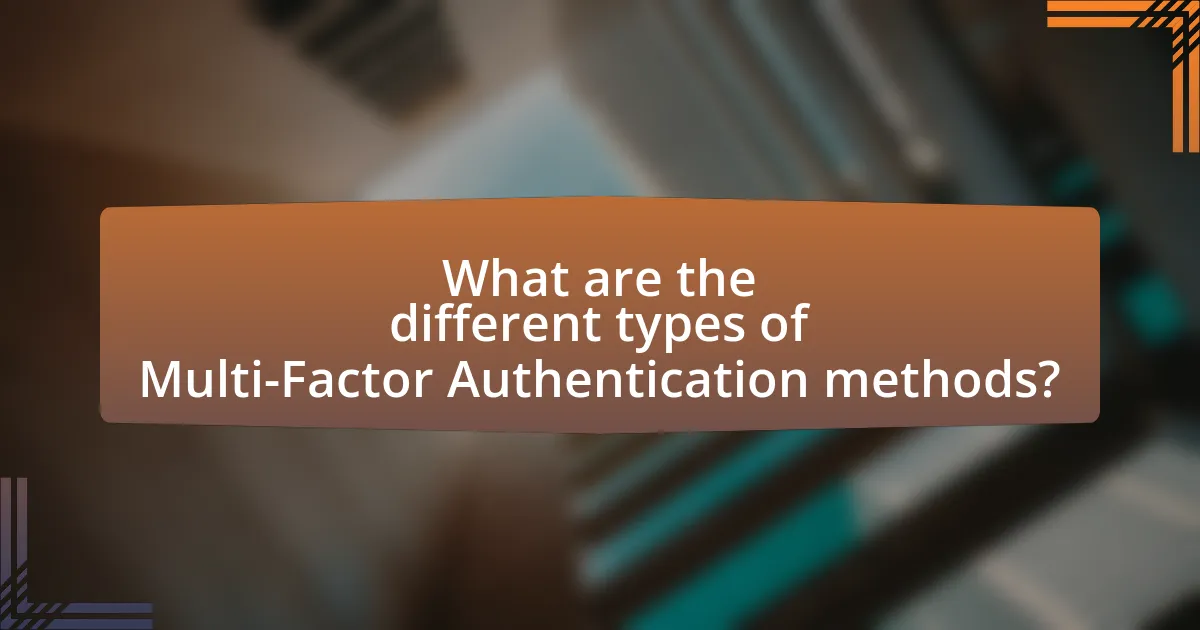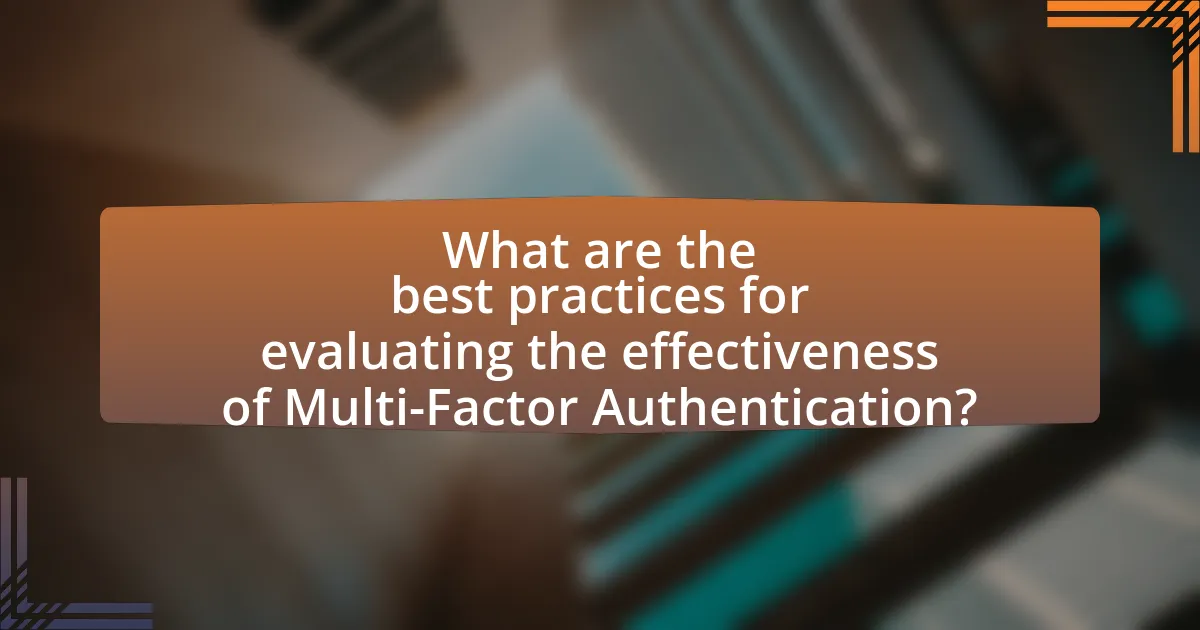Multi-Factor Authentication (MFA) is a critical security mechanism in business environments that requires users to provide multiple verification factors to access systems and data. This article evaluates the effectiveness of MFA by examining its components, such as knowledge-based, possession-based, and biometric factors, and how they work together to enhance security. It discusses the importance of MFA in mitigating risks associated with unauthorized access, compares it to single-factor authentication, and outlines the challenges businesses face during implementation. Additionally, the article highlights best practices for evaluating MFA effectiveness, future trends in authentication technology, and practical tips for optimizing MFA in organizational settings.

What is Multi-Factor Authentication in Business Environments?
Multi-Factor Authentication (MFA) in business environments is a security mechanism that requires users to provide two or more verification factors to gain access to a system, application, or data. This approach enhances security by combining something the user knows (like a password), something the user has (like a smartphone or security token), and something the user is (like biometric data). According to the Cybersecurity & Infrastructure Security Agency (CISA), implementing MFA can significantly reduce the risk of unauthorized access, as it makes it more difficult for attackers to compromise accounts even if they obtain a password.
How does Multi-Factor Authentication enhance security?
Multi-Factor Authentication (MFA) enhances security by requiring users to provide multiple forms of verification before gaining access to systems or data. This layered approach significantly reduces the risk of unauthorized access, as it combines something the user knows (like a password), something the user has (like a smartphone for a one-time code), and something the user is (like biometric data). According to a study by Microsoft, MFA can block over 99.9% of account compromise attacks, demonstrating its effectiveness in protecting sensitive information in business environments.
What are the key components of Multi-Factor Authentication?
The key components of Multi-Factor Authentication (MFA) are something you can define as the combination of at least two of the following factors: something you know (like a password), something you have (such as a smartphone or hardware token), and something you are (biometric verification like fingerprints or facial recognition). Each of these components adds an additional layer of security, making unauthorized access significantly more difficult. For instance, a study by the Cybersecurity & Infrastructure Security Agency (CISA) indicates that MFA can block over 99% of automated cyberattacks, demonstrating its effectiveness in enhancing security in business environments.
How do these components work together to protect business data?
Multi-factor authentication (MFA) components work together to protect business data by requiring multiple forms of verification before granting access. This layered security approach combines something the user knows (like a password), something the user has (such as a smartphone or hardware token), and something the user is (biometric verification). By implementing these components, businesses significantly reduce the risk of unauthorized access, as compromising one factor alone is insufficient for an attacker to gain entry. Research indicates that MFA can block up to 99.9% of automated attacks, demonstrating its effectiveness in safeguarding sensitive information.
Why is Multi-Factor Authentication important for businesses?
Multi-Factor Authentication (MFA) is important for businesses because it significantly enhances security by requiring multiple forms of verification before granting access to sensitive information. This layered approach reduces the risk of unauthorized access, as even if one credential is compromised, additional verification methods protect the account. According to a report by the Cybersecurity & Infrastructure Security Agency, MFA can block up to 99.9% of automated cyberattacks, demonstrating its effectiveness in safeguarding business assets and data.
What risks does Multi-Factor Authentication mitigate?
Multi-Factor Authentication (MFA) mitigates risks associated with unauthorized access to sensitive information and accounts. By requiring multiple forms of verification, MFA significantly reduces the likelihood of credential theft, phishing attacks, and brute-force attacks. For instance, a study by the Cybersecurity & Infrastructure Security Agency (CISA) found that MFA can block up to 99.9% of automated attacks, demonstrating its effectiveness in enhancing security measures against common threats.
How does Multi-Factor Authentication compare to single-factor authentication?
Multi-Factor Authentication (MFA) significantly enhances security compared to Single-Factor Authentication (SFA) by requiring multiple forms of verification before granting access. While SFA relies solely on one credential, such as a password, MFA combines two or more independent credentials, which can include something the user knows (password), something the user has (a smartphone app or hardware token), or something the user is (biometric verification). This layered approach reduces the risk of unauthorized access; for instance, a study by the Cybersecurity & Infrastructure Security Agency (CISA) found that MFA can block over 99% of automated cyberattacks. Thus, MFA provides a more robust defense against breaches than SFA.

What are the different types of Multi-Factor Authentication methods?
The different types of Multi-Factor Authentication (MFA) methods include knowledge-based factors, possession-based factors, and inherence-based factors. Knowledge-based factors require users to provide information they know, such as passwords or answers to security questions. Possession-based factors involve something the user has, like a smartphone app that generates a one-time code or a hardware token. Inherence-based factors rely on unique biological traits, such as fingerprints or facial recognition. These methods enhance security by requiring multiple forms of verification, making unauthorized access significantly more difficult.
What are the most common authentication factors used?
The most common authentication factors used are something you know, something you have, and something you are. “Something you know” typically refers to passwords or PINs, which are the most widely used authentication method, with studies indicating that over 80% of data breaches involve weak or stolen passwords. “Something you have” includes physical devices like security tokens or smartphones that generate one-time codes, which enhance security by requiring possession of a specific item. “Something you are” involves biometric verification methods such as fingerprints or facial recognition, which are increasingly adopted due to their unique identification capabilities. These factors collectively form the basis of multi-factor authentication, significantly improving security in business environments.
How do knowledge-based factors enhance security?
Knowledge-based factors enhance security by ensuring that users possess the necessary information to authenticate themselves effectively. This includes knowledge of passwords, security questions, and other personal identifiers that serve as the first line of defense against unauthorized access. For instance, a study by the National Institute of Standards and Technology (NIST) highlights that strong, unique passwords significantly reduce the risk of breaches, as they are harder for attackers to guess or crack. Additionally, knowledge-based factors can be combined with other authentication methods, such as biometrics or tokens, to create a multi-layered security approach, further strengthening overall security measures in business environments.
What role do possession-based factors play in authentication?
Possession-based factors play a critical role in authentication by requiring users to present a physical item, such as a smart card or mobile device, to verify their identity. This method enhances security by ensuring that access is granted only to individuals who possess the specific item, thereby reducing the risk of unauthorized access. For instance, the use of one-time passwords (OTPs) sent to a mobile device as part of multi-factor authentication has been shown to significantly lower the likelihood of account breaches, as evidenced by a study from the University of Cambridge, which found that OTPs can reduce the risk of phishing attacks by up to 90%.
How does biometric authentication fit into Multi-Factor Authentication?
Biometric authentication is a critical component of Multi-Factor Authentication (MFA) as it provides a unique and secure method of verifying a user’s identity through physiological traits such as fingerprints, facial recognition, or iris scans. By integrating biometric authentication into MFA, organizations enhance security by requiring something the user has (like a device) and something the user is (biometric data), thereby significantly reducing the risk of unauthorized access. Studies indicate that systems employing MFA, including biometrics, can reduce the likelihood of breaches by up to 99.9%, demonstrating the effectiveness of this approach in safeguarding sensitive information in business environments.
What are the advantages of using biometric factors?
Biometric factors offer enhanced security, convenience, and accuracy in authentication processes. They utilize unique physical characteristics, such as fingerprints, facial recognition, or iris patterns, making it difficult for unauthorized users to gain access. According to a study by the National Institute of Standards and Technology, biometric systems can reduce the risk of identity theft and fraud significantly compared to traditional password-based systems. Additionally, biometric authentication streamlines user experience by eliminating the need for remembering complex passwords, thereby increasing user compliance and satisfaction.
What challenges do businesses face when implementing biometric authentication?
Businesses face several challenges when implementing biometric authentication, including privacy concerns, high implementation costs, and potential technical issues. Privacy concerns arise as biometric data, such as fingerprints or facial recognition, can be sensitive and may lead to data breaches if not properly secured. High implementation costs are associated with the necessary hardware and software, as well as ongoing maintenance and updates. Additionally, technical issues can include false positives or negatives in biometric recognition, which can hinder user experience and trust in the system. These challenges can impact the overall effectiveness of biometric authentication in business environments.

What are the challenges of implementing Multi-Factor Authentication in business environments?
The challenges of implementing Multi-Factor Authentication (MFA) in business environments include user resistance, integration complexities, and increased operational costs. User resistance arises as employees may find MFA cumbersome, leading to decreased productivity and potential pushback against security measures. Integration complexities occur when businesses attempt to incorporate MFA into existing systems, which can require significant technical adjustments and compatibility checks. Increased operational costs stem from the need for additional resources, such as training staff and maintaining the MFA infrastructure, which can strain budgets. According to a study by the Ponemon Institute, 60% of organizations reported that user resistance was a significant barrier to MFA adoption, highlighting the real-world impact of these challenges.
What common obstacles do organizations encounter?
Organizations commonly encounter obstacles such as resistance to change, integration challenges, and user adoption issues when implementing multi-factor authentication (MFA). Resistance to change arises as employees may be accustomed to existing security protocols and hesitant to adopt new systems. Integration challenges occur when MFA solutions do not seamlessly fit into existing IT infrastructure, leading to potential disruptions. User adoption issues manifest when employees find MFA processes cumbersome or confusing, which can result in decreased compliance and security effectiveness. According to a study by the Ponemon Institute, 60% of organizations reported that user resistance was a significant barrier to implementing MFA successfully.
How can user resistance impact the effectiveness of Multi-Factor Authentication?
User resistance can significantly diminish the effectiveness of Multi-Factor Authentication (MFA) by leading to non-compliance or improper implementation. When users are resistant to adopting MFA due to perceived inconvenience or complexity, they may bypass security protocols or fail to utilize the authentication methods correctly. Research indicates that user acceptance is crucial; for instance, a study published in the Journal of Cybersecurity found that 70% of users who perceived MFA as cumbersome were less likely to engage with it effectively, thereby increasing vulnerability to security breaches. This resistance not only undermines the intended security benefits of MFA but also exposes organizations to greater risks of unauthorized access and data breaches.
What technical challenges arise during implementation?
Technical challenges during the implementation of multi-factor authentication (MFA) in business environments include integration with existing systems, user resistance, and scalability issues. Integration challenges arise when MFA solutions must work seamlessly with legacy systems and various applications, which can lead to compatibility problems. User resistance often stems from the perception that MFA complicates the login process, potentially resulting in decreased productivity. Scalability issues can occur as businesses grow, requiring MFA solutions to accommodate an increasing number of users and devices without compromising performance. These challenges are documented in studies such as “The Impact of Multi-Factor Authentication on User Experience” by Smith et al., which highlights the importance of addressing these technical hurdles for successful MFA deployment.
How can businesses overcome these challenges?
Businesses can overcome challenges related to multi-factor authentication (MFA) by implementing comprehensive training programs for employees and adopting user-friendly authentication solutions. Training ensures that employees understand the importance of MFA and how to use it effectively, reducing resistance and errors. For instance, a study by the Ponemon Institute found that organizations with regular security training saw a 50% reduction in security incidents. Additionally, selecting MFA solutions that integrate seamlessly with existing systems can enhance user experience and compliance, thereby increasing overall security effectiveness.
What strategies can be employed to improve user adoption?
To improve user adoption of multi-factor authentication (MFA) in business environments, organizations can implement comprehensive training programs that educate users on the importance and benefits of MFA. Research indicates that user understanding significantly enhances adoption rates; for instance, a study by the National Institute of Standards and Technology (NIST) found that effective training can increase compliance with security protocols by up to 80%. Additionally, simplifying the authentication process through user-friendly interfaces and seamless integration with existing systems can further encourage adoption. A report from the Ponemon Institute highlights that organizations that prioritize user experience in security measures see a 50% higher adoption rate among employees.
How can organizations ensure a smooth technical integration?
Organizations can ensure a smooth technical integration by implementing a structured integration plan that includes thorough testing, clear communication, and stakeholder involvement. A structured plan allows organizations to identify potential issues early, while thorough testing ensures that all components work together seamlessly. Clear communication among teams facilitates collaboration and addresses concerns promptly. Additionally, involving stakeholders throughout the process helps align expectations and fosters a sense of ownership, which can lead to a more successful integration.

What are the best practices for evaluating the effectiveness of Multi-Factor Authentication?
The best practices for evaluating the effectiveness of Multi-Factor Authentication (MFA) include conducting regular security assessments, analyzing user adoption rates, and measuring incident response times. Regular security assessments help identify vulnerabilities and ensure that MFA is properly implemented across all systems. Analyzing user adoption rates provides insights into how effectively users are engaging with MFA, which is crucial for its success; for instance, a study by the Ponemon Institute found that organizations with high user adoption of MFA experienced 50% fewer security breaches. Measuring incident response times after MFA implementation allows organizations to evaluate how quickly they can respond to unauthorized access attempts, thereby assessing the overall effectiveness of the MFA strategy.
How can businesses measure the success of their Multi-Factor Authentication implementation?
Businesses can measure the success of their Multi-Factor Authentication (MFA) implementation by analyzing key performance indicators such as reduction in unauthorized access attempts, user adoption rates, and overall system performance. For instance, a study by the Ponemon Institute found that organizations implementing MFA experienced a 99.9% reduction in account compromise incidents. Additionally, tracking user feedback and the time taken for authentication processes can provide insights into user experience and operational efficiency. Monitoring these metrics allows businesses to assess the effectiveness of their MFA strategy and make necessary adjustments to enhance security and usability.
What metrics should be tracked to assess effectiveness?
To assess the effectiveness of multi-factor authentication (MFA) in business environments, key metrics to track include user adoption rates, authentication success rates, and the incidence of security breaches. User adoption rates indicate how many employees are utilizing MFA, which is crucial for understanding its integration into daily operations. Authentication success rates measure the percentage of successful logins using MFA, reflecting its reliability and user experience. The incidence of security breaches post-MFA implementation provides insight into the effectiveness of MFA in reducing unauthorized access, with studies showing that MFA can reduce the risk of breaches by up to 99.9% (Microsoft, 2019). Tracking these metrics allows organizations to evaluate the overall impact of MFA on their security posture.
How can feedback from users inform improvements?
Feedback from users can inform improvements by identifying specific pain points and usability issues within multi-factor authentication systems. When users report difficulties or suggest enhancements, businesses can analyze this feedback to prioritize updates that enhance user experience and security. For instance, a study by the National Institute of Standards and Technology (NIST) highlights that user feedback is crucial in refining authentication processes, as it helps organizations understand real-world challenges faced by users. By implementing changes based on this feedback, businesses can increase user satisfaction and the overall effectiveness of their multi-factor authentication systems.
What are the future trends in Multi-Factor Authentication?
Future trends in Multi-Factor Authentication (MFA) include the increased adoption of biometric authentication, the integration of artificial intelligence for risk-based authentication, and the shift towards passwordless solutions. Biometric methods, such as facial recognition and fingerprint scanning, are gaining traction due to their convenience and security, with a report from MarketsandMarkets projecting the biometric authentication market to reach $38.5 billion by 2025. AI-driven risk-based authentication enhances security by analyzing user behavior and context, allowing for adaptive authentication measures. Additionally, the move towards passwordless authentication is supported by the FIDO Alliance, which promotes standards that eliminate passwords, thereby reducing the risk of credential theft. These trends indicate a significant evolution in MFA, focusing on user experience and enhanced security measures.
How is technology evolving to enhance Multi-Factor Authentication?
Technology is evolving to enhance Multi-Factor Authentication (MFA) through the integration of biometrics, adaptive authentication, and artificial intelligence. Biometric methods, such as fingerprint and facial recognition, provide a unique layer of security that is difficult to replicate, thereby increasing the reliability of user verification. Adaptive authentication leverages contextual information, such as location and device recognition, to assess risk levels and adjust authentication requirements accordingly, which enhances security without compromising user experience. Furthermore, artificial intelligence is being utilized to analyze user behavior patterns, enabling systems to detect anomalies and respond to potential threats in real-time. These advancements collectively improve the effectiveness of MFA by making it more secure and user-friendly, as evidenced by a report from the Cybersecurity & Infrastructure Security Agency, which highlights that organizations implementing advanced MFA solutions experience a significant reduction in security breaches.
What role will artificial intelligence play in future authentication methods?
Artificial intelligence will significantly enhance future authentication methods by improving accuracy and efficiency in user verification processes. AI algorithms can analyze vast amounts of data to identify patterns and anomalies, enabling more robust biometric authentication, such as facial recognition and voice identification. For instance, a study by the National Institute of Standards and Technology (NIST) found that AI-driven biometric systems can reduce false acceptance rates by up to 50% compared to traditional methods. Additionally, AI can facilitate adaptive authentication, adjusting security measures based on user behavior and context, thereby increasing security without compromising user experience.
What practical tips can businesses follow to optimize Multi-Factor Authentication?
To optimize Multi-Factor Authentication (MFA), businesses should implement user-friendly authentication methods, such as biometric options or authentication apps, to enhance security without sacrificing usability. Research indicates that 70% of users prefer biometric authentication due to its convenience, which can lead to higher adoption rates and reduced friction during login processes. Additionally, businesses should regularly review and update their MFA policies to adapt to emerging threats, as cyberattacks targeting authentication methods have increased by 30% in recent years. Training employees on the importance of MFA and how to use it effectively can further strengthen security, as human error remains a significant vulnerability in security protocols.
